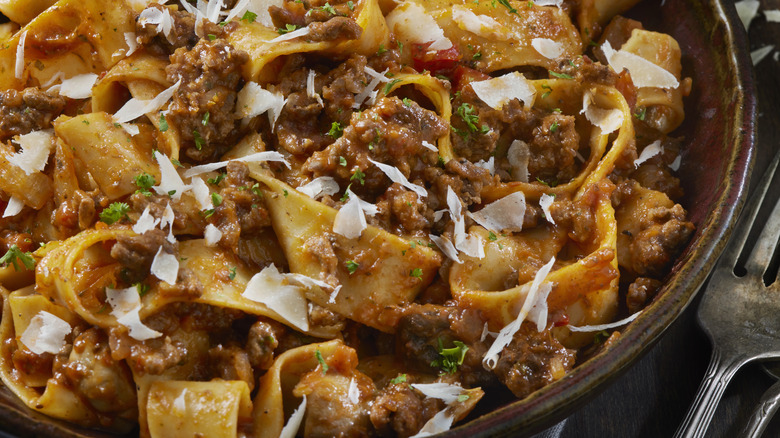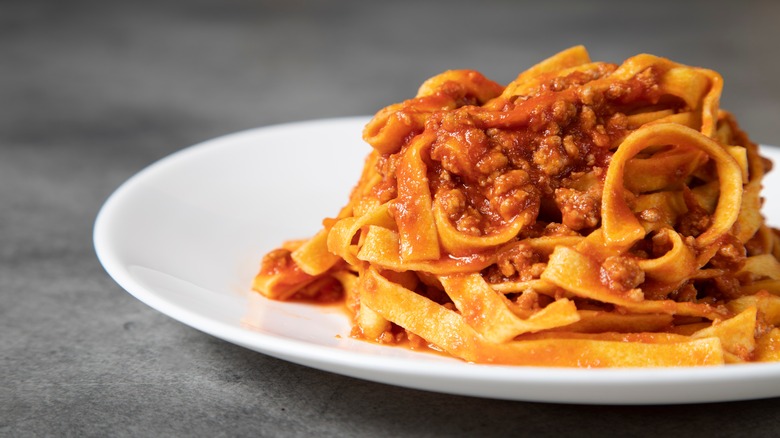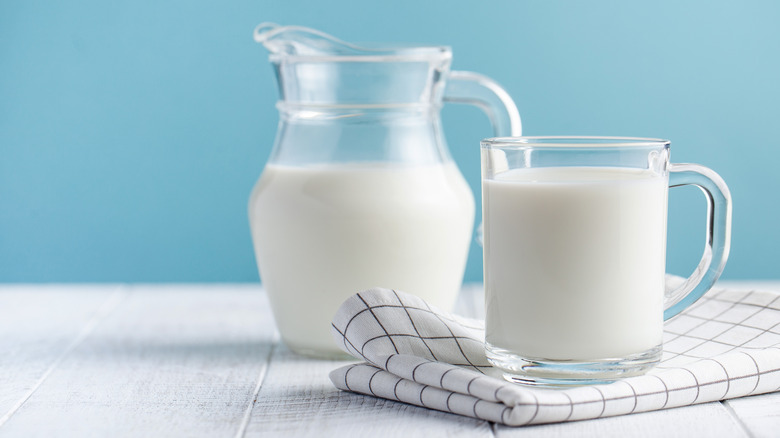The Ingredient J. Kenji López-Alt Says Is Crucial For A Perfect Bolognese
If you're wondering how exactly to define what Bolognese sauce is, the answer is a bit complicated. While many people picture a combination of ground beef and tomato sauce coupled with the holy trinity of carrots, celery, and onion, the makeup varies from region to region. Some recipes emphasize broth while others lean into wine. If we go with the dish registered with the Chamber of Commerce in Bologna, Italy, the ingredient list includes chopped beef, pork belly, carrots, celery, onions, tomato sauce or peeled tomatoes, dry white wine, broth, olive oil or butter, salt, pepper, and a somewhat controversial ingredient — dairy.
Then again, if we see what food consultant, columnist, author, and chef J. Kenji López-Alt has to say in regard to the dairy-or-no-dairy in the Bolognese debate, the answer is clear. As he outlines in Serious Eats, Bolognese just wouldn't be the same without milk or cream. Why? For the simple reason that it enriches the flavor of the sauce and helps to emulsify the delectable dish.
Make it creamy
After the slow-cooking ingredients reduce to a chunky mixture of meat and a bit of sauce, López-Alt says he finishes his Bolognese sauce with heavy cream. This is a commonly accepted method among modern cooks. Most simple Bolognese sauce recipes use some form of dairy at the end of the simmer, whether that be a rich milk or a heavy cream. Even the Bolognese recipe registered in 1982 in order to legitimize its cultural regional heritage recognizes the addition of dairy with the use of ½ cup of whole milk. If the town that takes credit as the birthplace of the dish says to add the dairy, who are we to argue?
While the addition of milk or cream to a tomato-based sauce may seem a little "off base," its inclusion serves a few functions. The first is to soften the tartness and acidity of the tomatoes. At the same time, it brings a subtle creaminess to the sauce, which might otherwise be described as a velvety finish. Finally, that emulsification López-Alt mentioned means that the cream will blend with the fats from the meat sauce, creating a more uniform texture. In the end, it's not that odd. After all, you can transform a can of tomato sauce into a comforting soup with little more than some added cream.
The dairy debate
While most cooks agree that cream is a must in the finishing stages, there are chefs who argue that also adding milk to the meat near the beginning will keep the meat from drying out. Whether you're in the camp of pork belly, beef, or veal, a slow-simmering sauce certainly runs a risk of sucking the moisture out of meat. The idea is that by adding milk to the pot after browning the meat, the dairy will keep it moist while it continues to simmer. However, some chefs debate whether the fact that the liquid is milk actually contributes anything more than simply using broth, the juice from the tomatoes, or wine.
López-Alt ran a little experiment with his Bolognese and concluded, "Turns out, the liquid you cook the meat in has absolutely no bearing on how tender the result. Meat cooked in stock is indistinguishable from meat cooked in milk. That said, adding milk to the cooking liquid and letting it reduce does have an effect on the finished flavor of the ragù, giving it a more rounded profile and silkier texture. Perhaps it's the silkiness of the liquid in your mouth that tricks some people into believing that the meat itself is more tender? Either way, it's clear that adding milk is a good thing." So there you have it. Cook like a master chef and add some dairy to your next batch of Bolognese.


